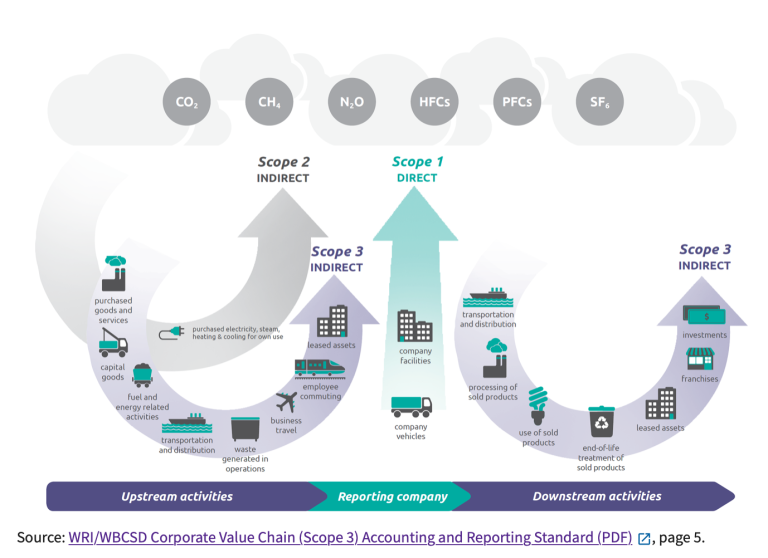Decoding sustainability:
All the definitions you need

Have you ever opened Google and wondered what exactly they mean when they say they have been “carbon neutral since 2007”? Or what Amazon really means when they commit to being Net Zero by 2040?
If the answer is yes, then you’re not alone. Research shows that 89% of people in the UK have heard of Net Zero but only 14% claim to have “a lot” of knowledge about the concept.
So, what do all these terms mean?
- Net Zero: Put simply, Net Zero means achieving a balance between the amount of greenhouse gases (GHG) produced and the amount removed from the atmosphere. In business terms, this means reducing your GHG emissions as much as possible. According to the Net Zero Standard, businesses should reduce their full value-chain emission by 90-95% and then offset the remaining emissions.
- Carbon Neutral: Carbon neutral is slightly different to Net Zero. Being carbon neutral means that a company achieves a balance between the amount of CO2 it emits and offsets. However, this doesn’t necessarily mean that a company is Net Zero, as they might only be offsetting their emissions and not actually reducing them. Net Zero is all about reducing GHG emissions to zero.
- Greenhouse gases (GHG) include:
- Carbon dioxide from burning fuel.
- Methane from cattle and other ruminants, decomposing organic waste, manure, leaking natural gas, land transformation and rice.
- Nitrous oxide from agriculture through fertilisers and crops.
- Fluorinated gases mostly from refrigerant leakages and other industrial processes.
- Nitrogen trifluoride which is primarily produced in manufacturing.
- An organisation’s full value chain includes their scope 1, 2 and 3 emissions which are often referred to as direct emissions (e.g. from company owned vehicles, manufacturing processes), indirect emissions (i.e. purchased energy such as the electricity used to power your lights), and non-owned indirect emissions (i.e. emissions from your supply chain, business travel and end-of-life treatment of sold products).

- Carbon offsetting: Carbon offsetting refers to investing in projects that remove carbon dioxide from the atmosphere, such as reforestation and building renewable energy, to compensate for your emissions.
- Carbon footprint (also known as GHG accounting): Your carbon footprint is the emissions you produce across the three “scopes”. It includes all GHG emissions but is usually measured in equivalent tons of carbon dioxide (CO2-e).
Decoding sustainability:
All the definitions you need

Have you ever opened Google and wondered what exactly they mean when they say they have been “carbon neutral since 2007”? Or what Amazon really means when they commit to being Net Zero by 2040?
If the answer is yes, then you’re not alone. Research shows that 89% of people in the UK have heard of Net Zero but only 14% claim to have “a lot” of knowledge about the concept.
So, what do all these terms mean?
- Net Zero: Put simply, Net Zero means achieving a balance between the amount of greenhouse gases (GHG) produced and the amount removed from the atmosphere. In business terms, this means reducing your GHG emissions as much as possible. According to the Net Zero Standard, businesses should reduce their full value-chain emission by 90-95% and then offset the remaining emissions.
- Carbon Neutral: Carbon neutral is slightly different to Net Zero. Being carbon neutral means that a company achieves a balance between the amount of CO2 it emits and offsets. However, this doesn’t necessarily mean that a company is Net Zero, as they might only be offsetting their emissions and not actually reducing them. Net Zero is all about reducing GHG emissions to zero.
- Greenhouse gases (GHG) include:
- Carbon dioxide from burning fuel.
- Methane from cattle and other ruminants, decomposing organic waste, manure, leaking natural gas, land transformation and rice.
- Nitrous oxide from agriculture through fertilisers and crops.
- Fluorinated gases mostly from refrigerant leakages and other industrial processes.
- Nitrogen trifluoride which is primarily produced in manufacturing.
- An organisation’s full value chain includes their scope 1, 2 and 3 emissions which are often referred to as direct emissions (e.g. from company owned vehicles, manufacturing processes), indirect emissions (i.e. purchased energy such as the electricity used to power your lights), and non-owned indirect emissions (i.e. emissions from your supply chain, business travel and end-of-life treatment of sold products).

- Carbon offsetting: Carbon offsetting refers to investing in projects that remove carbon dioxide from the atmosphere, such as reforestation and building renewable energy, to compensate for your emissions.
- Carbon footprint (also known as GHG accounting): Your carbon footprint is the emissions you produce across the three “scopes”. It includes all GHG emissions but is usually measured in equivalent tons of carbon dioxide (CO2-e).
